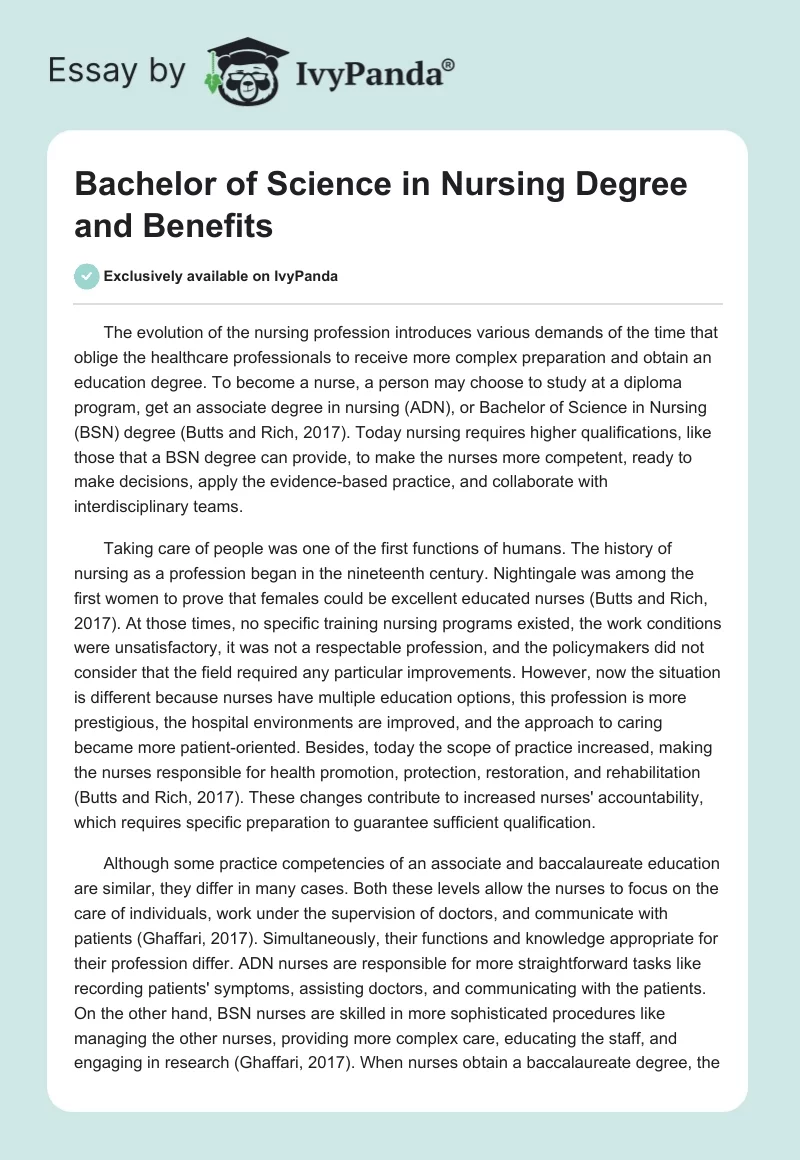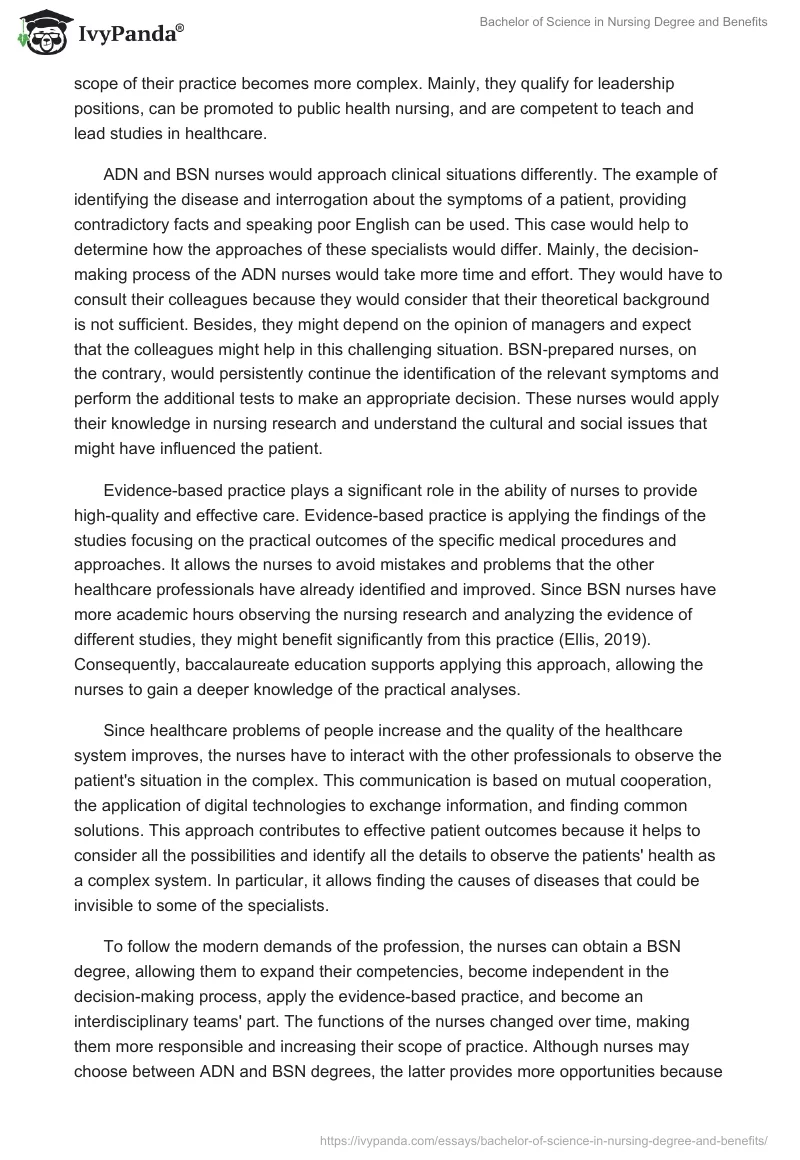The evolution of the nursing profession introduces various demands of the time that oblige the healthcare professionals to receive more complex preparation and obtain an education degree. To become a nurse, a person may choose to study at a diploma program, get an associate degree in nursing (ADN), or Bachelor of Science in Nursing (BSN) degree (Butts and Rich, 2017). Today nursing requires higher qualifications, like those that a BSN degree can provide, to make the nurses more competent, ready to make decisions, apply the evidence-based practice, and collaborate with interdisciplinary teams.
Taking care of people was one of the first functions of humans. The history of nursing as a profession began in the nineteenth century. Nightingale was among the first women to prove that females could be excellent educated nurses (Butts and Rich, 2017). At those times, no specific training nursing programs existed, the work conditions were unsatisfactory, it was not a respectable profession, and the policymakers did not consider that the field required any particular improvements. However, now the situation is different because nurses have multiple education options, this profession is more prestigious, the hospital environments are improved, and the approach to caring became more patient-oriented. Besides, today the scope of practice increased, making the nurses responsible for health promotion, protection, restoration, and rehabilitation (Butts and Rich, 2017). These changes contribute to increased nurses’ accountability, which requires specific preparation to guarantee sufficient qualification.
Although some practice competencies of an associate and baccalaureate education are similar, they differ in many cases. Both these levels allow the nurses to focus on the care of individuals, work under the supervision of doctors, and communicate with patients (Ghaffari, 2017). Simultaneously, their functions and knowledge appropriate for their profession differ. ADN nurses are responsible for more straightforward tasks like recording patients’ symptoms, assisting doctors, and communicating with the patients. On the other hand, BSN nurses are skilled in more sophisticated procedures like managing the other nurses, providing more complex care, educating the staff, and engaging in research (Ghaffari, 2017). When nurses obtain a baccalaureate degree, the scope of their practice becomes more complex. Mainly, they qualify for leadership positions, can be promoted to public health nursing, and are competent to teach and lead studies in healthcare.
ADN and BSN nurses would approach clinical situations differently. The example of identifying the disease and interrogation about the symptoms of a patient, providing contradictory facts and speaking poor English can be used. This case would help to determine how the approaches of these specialists would differ. Mainly, the decision-making process of the ADN nurses would take more time and effort. They would have to consult their colleagues because they would consider that their theoretical background is not sufficient. Besides, they might depend on the opinion of managers and expect that the colleagues might help in this challenging situation. BSN‐prepared nurses, on the contrary, would persistently continue the identification of the relevant symptoms and perform the additional tests to make an appropriate decision. These nurses would apply their knowledge in nursing research and understand the cultural and social issues that might have influenced the patient.
Evidence-based practice plays a significant role in the ability of nurses to provide high-quality and effective care. Evidence-based practice is applying the findings of the studies focusing on the practical outcomes of the specific medical procedures and approaches. It allows the nurses to avoid mistakes and problems that the other healthcare professionals have already identified and improved. Since BSN nurses have more academic hours observing the nursing research and analyzing the evidence of different studies, they might benefit significantly from this practice (Ellis, 2019). Consequently, baccalaureate education supports applying this approach, allowing the nurses to gain a deeper knowledge of the practical analyses.
Since healthcare problems of people increase and the quality of the healthcare system improves, the nurses have to interact with the other professionals to observe the patient’s situation in the complex. This communication is based on mutual cooperation, the application of digital technologies to exchange information, and finding common solutions. This approach contributes to effective patient outcomes because it helps to consider all the possibilities and identify all the details to observe the patients’ health as a complex system. In particular, it allows finding the causes of diseases that could be invisible to some of the specialists.
To follow the modern demands of the profession, the nurses can obtain a BSN degree, allowing them to expand their competencies, become independent in the decision-making process, apply the evidence-based practice, and become an interdisciplinary teams’ part. The functions of the nurses changed over time, making them more responsible and increasing their scope of practice. Although nurses may choose between ADN and BSN degrees, the latter provides more opportunities because it better educates healthcare specialists. BSN-prepared nurses can make decisions independently based on their knowledge of various theoretical and evidence-based studies. In addition, they can improve the patients’ outcomes by uniting their efforts with the other healthcare professionals.
References
Butts, J., & Rich, K. (2017). Philosophies and theories for advanced nursing practice. Jones & Bartlett Learning.
Ellis, P. (2019). Evidence-based practice in nursing. Learning Matters.
Ghaffari, M. (2017). Preparing Nurses for Community Health Care: A Comparative Study of the ADN and BSN Programs. International Journal, 5(2), 32-45.


